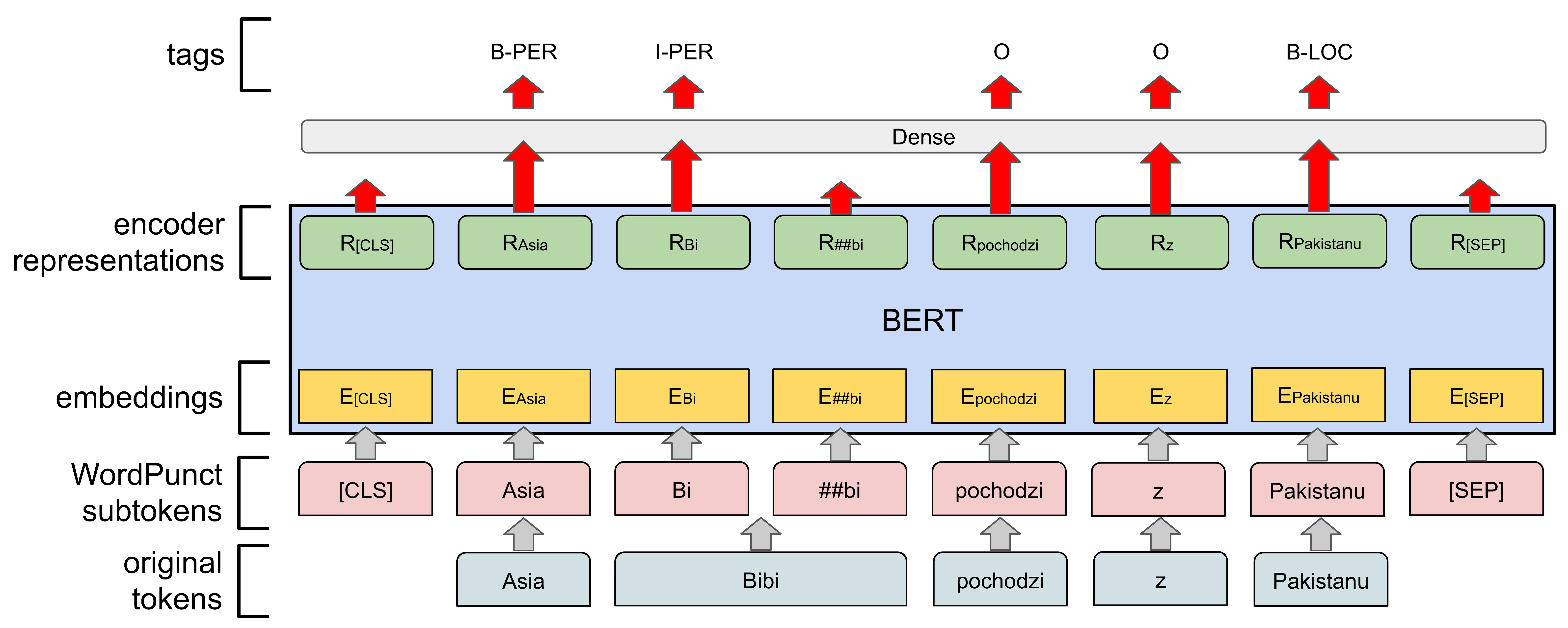BERT is a method of pre-training language representations, meaning that we train a general-purpose "language understanding" model on a large text corpus (like Wikipedia), and then use that model for downstream NLP tasks that we care about (like question answering). For details see original BERT github.
The repository contains Bulgarian+Czech+Polish+Russian specific:
Our academic paper which describes tuning Transformers for NER task in detail can be found here: https://www.aclweb.org/anthology/W19-3712/.
python predict.py --input raw.txt --output raw.predictions.txtpython predict.py --input ../ner-comparison/eval.tagged.txt --output ../ner-comparison/eval.tagged.slavic-bert.txtUsing alternative models
python predict.py --input ../ner-comparison/eval.tagged.txt --output ../ner-comparison/eval.tagged.rus_bert.txt --model rusСуд города Нью-Йорк снял с победительницы конкурса красоты «Мисс Россия-98» Анны Маловой обвинения в подделке рецептов на наркосодержащие медицинские препараты, сообщает Associated Press. Соответствующее решение было принято после прохождения Маловой курса лечения от наркотической зависимости. Принудительное лечение было назначено «Мисс России-98» также по решению суда. Также Малова, ныне постоянно проживающая в США, обвинялась в мелкой краже, подлоге и незаконном хранении наркотиков. Более десятка правонарушений за последние три года могли обернуться для нее семью годами тюрьмыСуд O
города O
Нью Loc
-Йорк O
снял O
с O
победительницы O
конкурса O
красоты O
«Мисс O
Россия Loc
-98» O
Анны Per
Маловой O
обвинения O
в O
подделке O
рецептов O
на O
наркосодержащие O
медицинские O
препараты O
, O
сообщает O
Associated O
Press O
. O
Соответствующее O
решение O
было O
принято O
после OThe Slavic model is the result of transfer from 2018_11_23/multi_cased_L-12_H-768_A-12 Multilingual BERT model to languages of Bulgarian (bg), Czech (cs), Polish (pl) and Russian (ru). The fine-tuning was performed with a stratified dataset of bg, cs and pl Wikipedias and ru news.
The model format is the same as in the original repository.
BERT, Slavic Cased: 4 languages, 12-layer, 768-hidden, 12-heads, 110M parameters, 600Mb
Named Entity Recognition (further, NER) is a task of recognizing named entities in text, as well as detecting their type.
We used Slavic BERT model as a base to build NER system. First, we feed each input word into WordPiece case-sensitive tokenizer and extract the final hidden representation corresponding to the first subtoken in each word. These representations are fed into a classification dense layer over the NER label set. A token-level CRF layer is also added on top.
The model was trained on BSNLP-2019 dataset. The pre-trained model can recognize such entities as:
- Persons (PER)
- Locations (LOC)
- Organizations (ORG)
- Products (PRO)
- Events (EVT)
The metrics for all languages and entities on test set are:
| Language | Tag | Precision | Recall | RPM (Relaxed Partial Matching) |
|---|---|---|---|---|
| cs | 94.3 | 93.4 | 93.9 | |
| ru | 88.1 | 86.6 | 87.3 | |
| bg | 90.3 | 84.3 | 87.2 | |
| pl | 93.3 | 93.0 | 93.2 | |
| PER | 94.2 | 95.6 | 94.9 | |
| LOC | 96.6 | 96.4 | 96.5 | |
| ORG | 84.3 | 92.1 | 88.0 | |
| PRO | 87.6 | 51.3 | 64.7 | |
| EVT | 39.4 | 27.7 | 93.9 | |
| 89.8 | 91.8 | 90.8 |
For detailed description of evaluation method see BSNLP-2019 Shared Task page.
NER, Slavic Cased: 4 languages, 13-layer + CRF, 768-hidden, 2.0Gb
The toolkit is implemented in Python 3.6 and requires a number of packages. To install all needed packages use:
$ pip3 install -r requirements.txtCAUTION: Python3.5 and Python3.7 are not supported, see DeepPavlov rep for details.
from deeppavlov import build_model
# Download and load model (set download=False to skip download phase)
ner = build_model("./ner_bert_slav.json", download=True)
# Get predictions
ner(["To Bert z ulicy Sezamkowej"])
# [[['To', 'Bert', 'z', 'ulicy', 'Sezamkowej']], [['O', 'B-PER', 'O', 'B-LOC', 'I-LOC']]]
ner(["Это", "Берт", "из", "России"])
# [[['Это'], ['Берт'], ['из'], ['России']], [['O'], ['B-PER'], ['O'], ['B-LOC']]]The Slavic Bert model can be used in any way proposed by the BERT developers.
One approach may be:
import tensorflow as tf
from bert_dp.modeling import BertConfig, BertModel
from deeppavlov.models.preprocessors.bert_preprocessor import BertPreprocessor
bert_config = BertConfig.from_json_file('./bg_cs_pl_ru_cased_L-12_H-768_A-12/bert_config.json')
input_ids = tf.placeholder(shape=(None, None), dtype=tf.int32)
input_mask = tf.placeholder(shape=(None, None), dtype=tf.int32)
token_type_ids = tf.placeholder(shape=(None, None), dtype=tf.int32)
bert = BertModel(config=bert_config,
is_training=False,
input_ids=input_ids,
input_mask=input_mask,
token_type_ids=token_type_ids,
use_one_hot_embeddings=False)
preprocessor = BertPreprocessor(vocab_file='./bg_cs_pl_ru_cased_L-12_H-768_A-12/vocab.txt',
do_lower_case=False,
max_seq_length=512)
with tf.Session() as sess:
# Load model
tf.train.Saver().restore(sess, './bg_cs_pl_ru_cased_L-12_H-768_A-12/bert_model.ckpt')
# Get predictions
features = preprocessor(["Bert z ulicy Sezamkowej"])[0]
print(sess.run(bert.sequence_output, feed_dict={input_ids: [features.input_ids],
input_mask: [features.input_mask],
token_type_ids: [features.input_type_ids]}))
features = preprocessor(["Берт", "с", "Улицы", "Сезам"])[0]
print(sess.run(bert.sequence_output, feed_dict={input_ids: [features.input_ids],
input_mask: [features.input_mask],
token_type_ids: [features.input_type_ids]}))[2] - Mozharova V., Loukachevitch N.: Two-stage approach in Russian named entity recognition, 2016
[3] - BSNLP-2019 Shared Task
